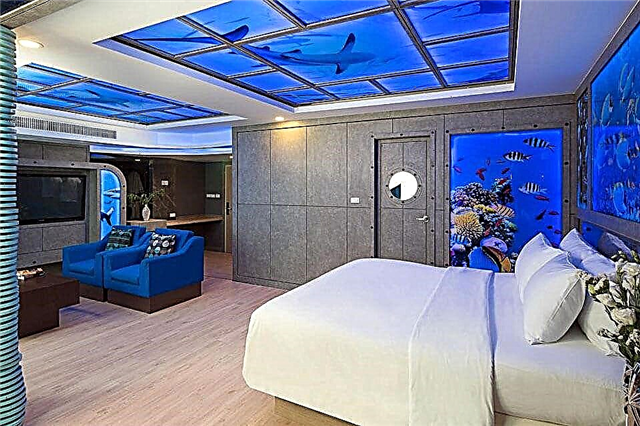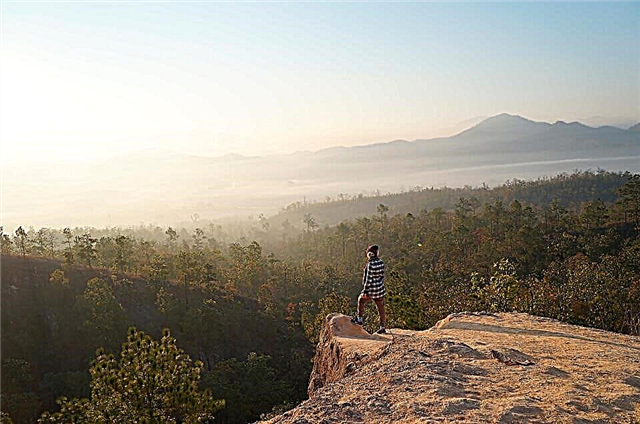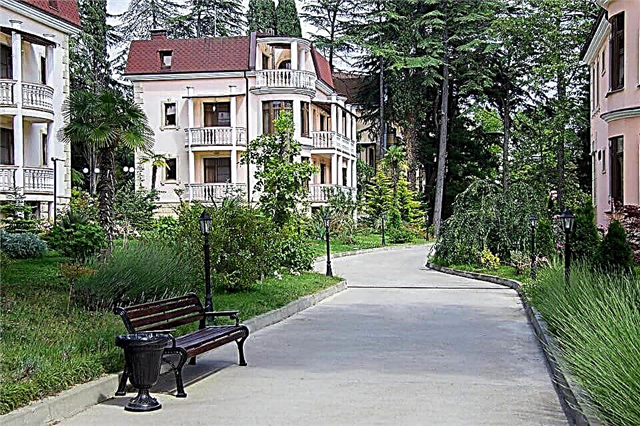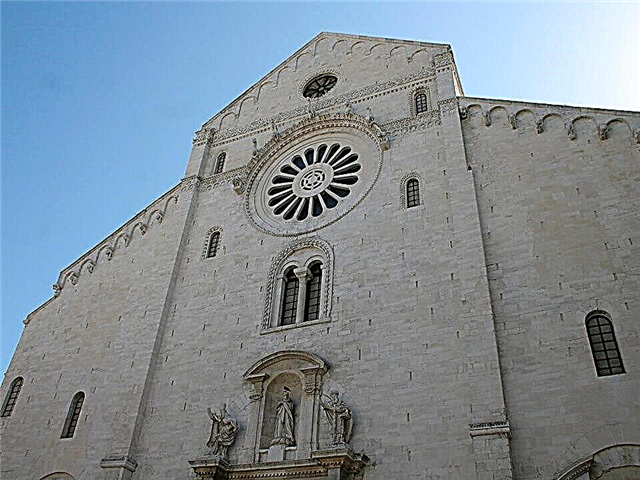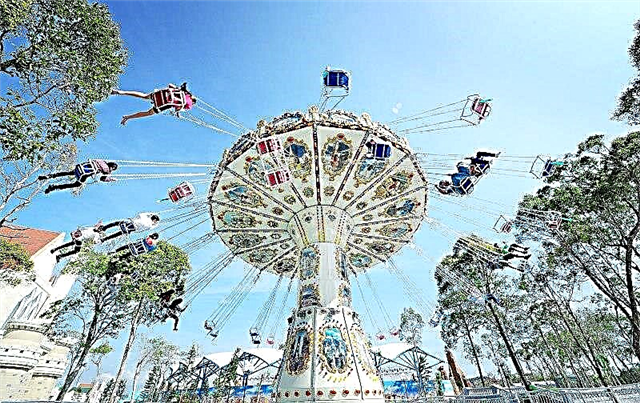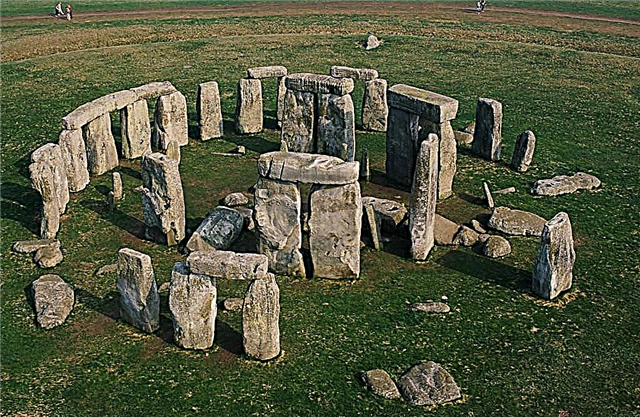In the 1st century BC, retired Roman legionaries founded a settlement and named it "Florence", which means: "Blooming". After 5 centuries, the settlement turned into a city of merchants and artisans, which was prepared for an amazing fate. The Florentine Republic was repeatedly conquered, plague epidemics almost completely destroyed its population, hostilities, natural disasters destroyed buildings and monuments, but it was reborn from ruins. The city became the birthplace of prominent artists, sculptors, poets, writers, scientists, thinkers, politicians of the Renaissance. It also attracted famous figures of Russian culture: Herzen, Dostoevsky, Tchaikovsky, Tolstoy, Tarkovsky, for whom ancient monuments, medieval palaces, ancient temples became sources of inspiration. The sights of Florence were and remain the hallmarks of Italy. For centuries, the city has retained the status of an economic, tourist, industrial center, the glory of one of the capitals of world fashion.
Basilica of Santa Croce

The Basilica is located in the very center of the city on the square of the same name. This is a huge building of extraordinary beauty. Translated into Russian, the name means "holy cross". That is why it is shaped like an Egyptian cross. Many famous people of Italy, who lived and worked in this country, rest here. The temple is very large.
Inside there are paintings, frescoes and sculptures by famous masters. Monuments of incredible beauty to Galileo Galilei, Michelangelo, Niccolo Machiavelli were erected along the walls of the basilica. Outside, there is a cozy and beautiful courtyard with sculptures and vegetation. There is a monument to the great Dante Alighieri. The entrance to the basilica is paid. Access for tourists opens at 9.30 am. The cost of the visit is about 8 euros. The price also includes a visit to the museum at the temple. It is forbidden to visit the basilica with bare arms and legs.
If your clothes do not comply with the rules, you can purchase a special scarf here. Photography in the temple is allowed, however, it is dark inside, which makes it difficult to take pictures. The best way to get to the Basilica of Santa Croce is on foot. The streets of the city are too small for a large number of tourists by car. For those who are afraid of getting lost, a bus tour can be booked. It will cost about 20 euros per person.
Uffizi Gallery

The Uffizi Gallery is famous all over the world. Here are collected unique and beautiful masterpieces of painting. Paintings by Leonard da Vinci, Raphael, Titian take us back hundreds of years. Monuments-sculptures rise in the courtyard of the gallery. On the first floor of the building there are temporary exhibitions, on the second - the main exhibitions. All paintings have been perfectly preserved, despite all their long history. The ceiling of the museum is striking in its magnificence. It is decorated with ancient moldings and frescoes depicting saints, angels and famous people. To get inside without long queues, it is better to arrive an hour before opening. And if you are resting at the height of the season, then two.
Tickets can be purchased online in advance. If you intend to stand in a live queue, then the entrance to the ticket office is on the right side of the building. Taking pictures in the gallery is allowed. For the convenience of visitors, there is a buffet in the building. Getting to the gallery is easy. It is located a 10-minute walk from the train station.
Giotto's bell tower

A high tower rises above the houses and buildings of Florence. Its height reaches 85 meters. It is just below the dome of the Cathedral of Santa Maria del Fiori, which is located next door. Climbing the bell tower is not easy. The journey takes about 15 minutes along a steep narrow staircase of 414 steps. There is little light and a little stuffy. But the view that opens from Giotto justifies all expectations and expended energy. Bright roofs of Florentine houses and green hills, gradually turning into the horizon.
A huge dome of the cathedral appears right before your eyes. The site provides an opportunity not only to admire the landscapes around, but also to see the structure of Santa Maria del Flori. A bird's eye view of Florence is an incredible sight. However, such an excursion should be abandoned by people who are afraid of heights or have diseases that make it difficult to climb the bell tower.
The entrance to the observation deck of the tower is paid. A cheaper option is a complex ticket. So you can visit two viewing platforms at once: the bell towers of Giotto and the Cathedral of Santa Maria del Fiori, as well as the Baptistery, the crypt of Saint Repera and the historical museum. Access to the tower is closed during religious holidays.
Palazzo Vecchio

Palazzo Vecchio was a government building several millennia ago. Now it is the town hall building, which is the main attraction of Piazza Signori. Italians consider the building to be a symbol of the city. The town hall consists of three tiers, with a jagged crown at the very top. The vaults of the building are decorated with 9 coats of arms of the guilds of the republics. The famous Arnolfo Clock Tower rises into the sky above the structure. By its watch, residents have been checking the time since the 17th century. In the 15th century, the tower served as a prison. Here were in custody those who were objectionable to the royal power and instigators of coups.
The interior of the palace is beautiful. Stone courtyards, chiseled statues, painted ceilings and incredible columns. All this luxury is complemented by greenery and dim lighting. On the walls of the courtyard, you can see the views of the old cities of Austria-Hungary. The sculptural ensemble Genius, created by Michelangelo, adorns the Hall of the Five Hundreds. The ceiling of the Lily Hall is covered with stucco moldings of incredible beauty, depicting honeycombs and flowers.
Palazzo Vecchio is also located in the center, so finding it will not be a problem. It accepts tourists from 9 am to 7 pm every day except Saturday. On Thursday, the Palazzo is open until 2 pm.
Palazzo Pitti

Palazzo Pitti is one of the most beautiful palaces in the city. Previously, royal dynasties lived here. Today, these are museums and art galleries that house sculptures, precious items and paintings by famous artists. The square in front of the Palazzo already attracts tourists with its interesting sculptures in the form of huge faces. The structure itself is made in the shape of a cube, and in the center there is a beautiful round fountain with small cupids. The second floor of the building is occupied by a gallery, rich in its decoration.
It consists of several rooms: Venus, Jupiter, Apollo, Mars and Saturn. In Palazzo Pitti you can visit the Gallery of Modern Art, the Silver Museum and the Carriage Museum. Taking pictures in the halls of the palace is strictly prohibited. However, no one forbids taking pictures of gorgeous views of the city and gardens from the windows. If you come to the ticket offices of Palazzo Pitti early in the morning, you can safely get on a tour without standing in a long line. Tourist activity here increases after 12 noon.
You can get to the palace by bus number 11 or 36 to the San Felice stop.
Ponte Vecchio bridge

Palazzo Pitti, the Uffizi Gallery and Palazzo Vecchio are connected by a 750 meter long corridor that runs across the Ponte Vecchio. The entrance to the building is closed, and Roberto Zanieri keeps the key. The building is also called the "Golden Bridge" because of the large number of jewelry stores located on it earlier. The bridge crosses the narrowest point of the Arno River. This is a very picturesque and romantic place in the city. Ponte Vecchio is the oldest bridge in the city. Its appearance has changed over the years. Wooden structures and butchers' shops were replaced by jewelry stores.
Now it houses modern boutiques and shopping stalls. However, the spirit of antiquity still reigns on Ponte Vecchio.This bridge is the only one that survived after the war. All other paths across the rivers were blown up. The terrible flood that ravaged all jewelry stores and flooded the houses on the bridge, Ponte Vecchio also withstood. The main bridge is always full of tourists, so it is very difficult to take pictures of beauty. But it is possible to admire them.
The observation decks offer a beautiful view of the river and the city. In the evenings, street musicians love to gather here. Residents call the bridge "a tragedy for men." A huge number of jewelry stores makes tourists leave with shopping for their wives. Here you can find unique products made of glass, stone, wood and metal. The bridge is open to tourists free of charge. It is located in the center, next to the Palazzo Pitti and the Uffizi Gallery.
Santa Maria del Fiore

The cathedral with the world's largest dome is called the heart of the city. Another very popular attraction of the city. It is located in the main square of the city - the Duomo. Its name translates as "St. Mary's flower". The second name of the cathedral is the same name of the square - Duomo. A construction of incredible size, in the shape of a Latin cross. The cathedral is striking in its grandeur and luxury. Its decoration combines 3 shades of marble: white, pink and green.
The facade of Santa Maria del Fiore is decorated with a statue of the Virgin Mary with a baby in her arms and a lily flower. On both sides of the sculpture there are statues of the 12 apostles. The huge dome of the cathedral is made of red brick. It can be seen from afar, so tourists quickly find the attraction. The dome weighs 37 thousand tons. Inside, Santa Maria del Fiore is no less interesting. Its architecture combines austerity and grandeur at the same time.
The frescoes, sculptures and glass paintings are modest but no less beautiful. The dome near the altar is painted with scenes from the Bible. Residents say that the decoration of the cathedral should not distract people from their conversation with God. Therefore, the interior of the Duomo is modestly decorated. Upstairs, from the observation deck, you can see all of Florence, accessible to the eye. Only Giotto's Bell Tower distracts the gorgeous view of the city. Here you can see it up close. It is always a crowded place.
The queues for the cathedral are always long. However, excursions are skipped out of line. Santa Maria del Fiore is open from 10 to 17 on Monday, Tuesday, Wednesday and Friday. The entrance to the Duomo is free, only the ascent to the dome is paid. It costs 6 euros, as well as a visit to the museum. A complex ticket for the ascent to the dome, museum, cemetery and excavations of Santa Reparata costs 8 euros. Free guided tours are held every day at certain times. The hours need to be checked on the spot.
Basilica of Santa Maria Novella

This is the name of the church, which is located next to the railway station on the square of the same name. If you arrive by train and then go on foot, then the temple is the first thing that catches your eye. Santa Maria Novella was built for the Rucellai family, which is why their coat of arms flaunts on the church. The temple has collected a large number of magnificent creations. In it you can see the tomb of Bishop Fiesole, a monument to Blessed Villana, a bust of St. Antonin.
The building is very beautiful inside, decorated with columns and arches. Not luxurious, but interesting and cozy. The beautiful ceiling of the temple is framed with marble. Large paintings can be seen on the walls. Wooden benches, several statues of Jesus Christ and the Virgin Mary. The church is widely known to tourists for its wonderful sculptures, stained glass windows and frescoes. Each of which has its own meaning and meaning. The altar in Santa Maria Novella is considered one of the most beautiful in the city. The chapels of the temple are decorated with frescoes by famous Italian masters.
A special place is occupied by the inner courtyard of the church. It is very nice and cozy. Situated in the middle between city bustle and church life, the courtyard is surrounded by greenery, columns and galleries. Its walls are adorned with biblical paintings and gorgeous frescoes. There is a famous old pharmacy next to the temple. It is not part of it, however, it is located in the territory of Santa Maria Novella.
Finding a church will not be difficult.
Basilica of San Lorenzo

The first mention of the church dates back to 393 AD. The basilica was built and underwent changes for many centuries. Until the great Michelangelo Buonarroti became the architect of the temple in 1520. The church serves as a burial place for members of noble Florentine families. Michelangelo did something unprecedented at that time. He placed the tombs not in the center, as everyone else did, but along the entire perimeter, along the walls. The famous master never finished the facade of the basilica.
He could not find a common language with Pope Leo X Medici, who commissioned Michelangelo to work. The Basilica of San Lorenzo, unlike other churches, is not particularly eye-catching from the outside. However, getting inside, you don't want to leave it for a long time. High columns stretch towards the altar in an even formation. A beautiful drawing on the floor is by itself a work of art by great masters of their craft. The building of the Old Sacristy of the Basilica is decorated with ancient frescoes and bas-reliefs. The author of many works in it is Donatello. The sarcophagi of the Medici Dukes are located in the New Sacristy.
The sculptures in it were made by Michelangelo. The second largest dome in Florence is crowned by the Church of San Lorenzo. It is located in the Chapel of Princes. The dome is decorated with stunning frescoes depicting Bible scenes and coats of arms.
The library is also located here. It contains old editions of books and manuscripts. The basilica is located in St. Lawrence Square.
Baptistery of San Giovanni

The baptistery is part of the complex of the Cathedral of Santa Maria del Flore. This is an old place for baptism. Many noble people, including those from the Medici family, adopted Christianity here. The baptismal font is the oldest of all structures in the Duomo square. The baptistery is impressive in size. This is because people who converted to Christianity were already adults at that time. The building has eight corners and is topped with a dome. Each corner represents a day of the week. The baptismal has several doors to facilitate the flow of people in such a small structure during religious holidays.
Inside the baptistery is painted with beautiful scenes depicting saints. The bas-reliefs that adorn the gates of the building were made by renowned craftsmen. The most luxurious creation of San Giovanni is called "The Gates of Paradise". The eastern gate of the baptistery is decorated with 10 bas-reliefs. Each of them depicts stories from the Bible. The place near the font is quite crowded.
This is due to the location of other attractions nearby. There are a lot of tourists here during the high season. The baptistery is located in Piazza Duomo, near the Cathedral of Santa Maria del Flora. You will find it easily, focusing on the huge dome of the church and the bell tower of Giotto.
Academy Gallery

The Academy Gallery is known not only in Italy, but also abroad. It is a well-known museum with a long history and numerous exhibits. The Academy is called a reputable educational institution. And the collection of the Gallery is recognized as one of the most valuable in the whole world. Here you can find works by such masters as Michelangelo Buonarroti, Giambologna, Andrea Orcagna, Fra Bartolomeo. A huge marble statue of David was moved here in 1873. For many years she stood in the square in front of the Palazzo Vecchio, and suffered from the weather and vandalism.
Until a hall was built specifically for sculpture in the Gallery. Later, 6 more of Michelangelo's creations were moved to the museum. Paintings from the 14th century have been collected from many of the city's churches. A collection of paintings in the Gothic style, plaster models, Gothic altar images - you can see all this in the Academy Gallery. Getting to the museum is not difficult.
The gallery is located next to the Cathedral of Santa Maria del Flore, in the central part of the city.Buses No. 6, 14, 19, 31 go there.
Medici chapel

The Medici Chapel is located at the Church of San Lorenzo in the square of the same name. The architect of the project was the great Michelangelo Buonarroti. The chapel is called one of his finest creations. This building is small in size, elongated upward. Everything here carries the theme of death. The dead rest in this place. The famous Madonna and Child statue can be seen inside the chapel. The sculptures made by Michelangelo in the chapel made him famous all over the world. Figures of the Day: "Morning", "Day", "Evening" and "Night". They are filled with strength and tragedy.
The sculptures make an incredible impression on the visitors. You can get to the Capella by bus number 1C to the stop "San Lorenzo". The chapel is closed on major religious holidays, as well as every odd Monday of the month and every even Sunday.
Monastery and Church of San Marco

It is generally believed that the monastery was founded in the 13th century, however, in its place there were earlier Christian places of worship. Centuries later, the church, residential buildings, outbuildings turned out (under strange circumstances) to be the property of the famous Medici oligarchic family, whose representative transferred the buildings to the Dominican monks. This story was not without a scandal.
The richest Florentine families owned the plots of the temple and over the centuries invested in the renovation of the chapels "assigned to them". The Medici donated fabulous sums for the reconstruction of the church and neighboring buildings. Representatives of the dynasty supervised all restoration work, and as a result, the monastery buildings were decorated only with symbols of this kind.
Currently, the architectural complex is a museum. San Marco is known as a collection of unique handwritten, printed books (many of which belonged to the Medici family). Its library contains the works of ancient philosophers, monastic charters, the works of Thomas Aquinas and Augustine the Blessed. The museum houses the works of outstanding masters of the Renaissance, in its halls you can see the works of the canonized Beato Angelico, famous for his temple frescoes Benozzo Gozzoli, the founder of the famous dynasty of artists Domenico Ghirlandaio.
Bargello Museum

The National Museum is housed in the Bargello castle-palace. Over the past centuries, the building has managed to visit the residence of the head of the administration, a building for the meeting of the city council, a barracks, a prison, a place of execution of convicts, a police department, a sculpture museum. The construction of Bargello dates back to the middle of the XIII century, originally the castle was two-story.
In the XIV century, after a fire, the palace was repaired, significant changes were made to its exterior, and the third floor was added. Later, the building was repeatedly restored, equipped with an elevator, created conditions for visiting the premises by disabled people. The Bargello National Museum (the name of the building means: "tower", "castle", "chief of the guard", "judge") contains famous Italian relics created by masters of the Renaissance, including Michelangelo, Donatello, Cellini, Sangallo.
The exhibition halls house statues, bas-reliefs, commemorative medals, decorative elements of buildings destroyed in the 19th century. The redevelopment of the city that took place at that time is comparable in its consequences to a cultural catastrophe! To make the streets wider and more comfortable, the authorities decided to demolish unique structures, temples, whose splendor can be judged today by the exhibits of the museum.
House-Museum of Dante Alighieri

An inconspicuous three-story building in the old Florentine quarter attracts tourists from all over the world. The history of this building has not been without hoaxes and the desire of the townspeople to pass off the desired for reality. Only the foundation remains of the real home of the greatest Italian poet. The current walls of the building were erected at the beginning of the 20th century. The Florentines literally bit by bit were able to recreate on the second floor the interior of the rooms where Dante could live, the atmosphere that reigned in the house of the genius.
Involvement in political intrigues did not bring him happiness, he held the post of prior, was expelled from his hometown, wandered around Europe, returned to Italy, settled in Ravenna, became an ambassador and died before he could complete his diplomatic mission. The poet's muse, Beatrice, lived not far from the place where Dante's house-museum is located. The thinker's platonic love for a woman, whom he saw several times in his life, turned out to be stronger than logic, common sense, death, and inexorable time.
The invented ideal inspired Dante to create the famous poem "The Divine Comedy", numerous sonnets, poems. Copies of lifetime editions of works dedicated to Beatrice are on the top floor of the museum. The lower part of the building is a recreated pharmacy. Noble origin, the merits of ancestors did not automatically mean that the inhabitants of the Florentine Republic belonged to full citizens. To be among the second and have privileges, the poet joined the pharmacists' guild and could become (if fate were different) an outstanding pharmacist.
Palazzo Medici Riccardi

The three-story palace looks like a building that belonged to the Strozzi aristocratic dynasty, but the second palazzo was erected later. The double name of the historical monument, architecture reminds of the famous families, whose property it was: Medici and Riccardi. Today the public library is located in a three-tiered building. Its funds contain biblical manuscripts, copies of the works of ancient philosophers, politicians and thinkers of the Renaissance. The exterior design of the palace is austere, ascetic, and the interior is striking in luxury, well-thought-out harmonious planning.
The hallmark of the palazzo is a statue by Bandinelli, in the creation of which the master's contemporaries saw political overtones. The sculptor captured the myth of the pacification of the dog Cerberus by Orpheus, guarding the entrance to the world of the dead. The similarity between the face of the legendary musician and the lifetime portraits of power-hungry representatives of the Medici dynasty is noticeable even to people far from art. The same can be said about another palace relic - the statue of the Madonna and Child (the author of the sculpture: monk, adventurer, genius master of the Renaissance Filippo Lippi). The eastern part of the palace is occupied by a small family chapel. On her frescoes (the work of the famous Italian artist Gozzoli) in the images of saints, biblical characters, it is also easy to guess the portrait resemblance to the Medici.
Michelangelo Square

One of the city's main landmarks, the business card of Florence, is located on the top of the hill. The reason for the construction of the square was the reconstruction work on the left bank of the Arno River. It was originally planned that it would turn into a part of a single architectural complex. There was an idea to place a museum dedicated to Michelangelo's work in a special pavilion. It was not carried out, and today there is a restaurant in the building.
A magnificent alley leads to the square, the total length of which is 8 kilometers. A bronze copy of Michelangelo's statue of David was installed and opened in the square in 1873. At the foot of the biblical character, there are no less famous sculptures of allegories. 4 symbolic figures represent morning, evening, day, night. These are copies of sculptures - the originals are in the Basilica of San Larenzo and adorn the lids of the Medici family sarcophagi. Nowadays, part of the square is occupied by car parking. For those who want to admire the city from above, there is an observation deck nearby, which is part of a special tourist zone.
Signoria Square

There are squares with a similar name in other Italian cities: Padua and Verona.Historians say: originally there was an antique theater on the site of the Florentine square, later 36 towers that belonged to the powerful Uberti dynasty appeared here. Representatives of this family died in medieval internecine wars, a similar fate befell the buildings. The construction of the Señoria Palace, located on the square, dates back to the XIII-XIV centuries. Conventionally, both architectural, historical monuments are considered peers, but the difference in the dates of the foundation of the building and the area reaches 40 years. Once in this part of the city, political life was raging, meetings of citizens, executions of conspirators and heretics were held in the palace and on the adjacent territory.
The main attractions of the square - antique, medieval sculptures - represent a single harmonious allegorical cycle. Some of the figures are placed on a special loggia: a structure intended for public events (more modest in size galleries in Italy served as places for walks and rest for aristocrats). On the square you can see copies of works by Donatello and Michelangelo, original statues created by Bandinelli, Cellini, Giambologna, Fedi, Ammanati. In guidebooks, it is often compared to an open-air museum, where different eras are inextricably intertwined.
Vasari Corridor

The corridor that connects Palazzo Pitti in Piazza Signoria with the Boboli Gardens is named after the architect Giorgio Vasari. It was built as a secret passage by order of Cosimo Medici in 1565. The total length of the gallery was 1 km. In the 19th century, it housed paintings in the genre of self-portrait, depicting the famous Italian artists Titian, Raphael, Bernini and others. The collection currently includes about 1000 paintings from the 13th to 17th centuries. The gallery is closed to the general public.
For inspection, prior agreement is required. Tours are available from 9.30 am (Tue-Sun).
Boboli Gardens

The park area owes its appearance to Duchess Eleanor of Toledskaya, a visionary politician, generous philanthropist, and a beautiful woman. By her order, an amphitheater was erected in the gardens, where the builders erected an ancient Egyptian obelisk from Luxor. The artifact once adorned one of the Medici villas. There are legends that the former owners of the obelisk died under strange circumstances. The Duchess decided to outsmart fate and ... she died at the age of 40 from malaria. Of Eleanor's 11 children, three survived to adulthood. It is noteworthy: the main favorite of the dowager duke turned out to be the namesake of his wife and after 40 years "died to the world" (she was forcibly tonsured into a nun).
The Florentine park ensemble, founded by the order of Eleanor of Toledo, has become the standard of classical landscape design. Today, the Boboli Gardens cover about 4.5 hectares. It is difficult for foreign tourists and local residents to imagine that many centuries ago a quarry functioned on this place. Terraces, fountains, grottoes, gazebos, antique sculptures, works of Renaissance masters have created an amazing atmosphere here, where aristocracy, luxury, sophistication and harmony reign. Versailles and other well-known European parks were laid out on the model of the Boboli gardens, whose layout experts still call perfect.
Medici Laurentian Library

The library was collected by several generations of the famous Medici dynasty. Nowadays, more than 150 thousand handwritten, printed books are kept in its funds: from ancient Egyptian papyri to European editions of the XIV-XV centuries, whose circulation did not exceed 100-300 copies. The owners of the unique collection have changed several times. When the power of the Medici weakened, the library fell into the hands of the clergy, city authorities. Today it belongs to the state. The building where the rare books are located is open to the public.
The library was founded as a personal collection of rare editions, manuscripts in 1444. The building for storing books, manuscripts, papyri was erected almost 100 years later. The author of his project was the brilliant artist, architect, sculptor Michelangelo. The premises of the library were originally designed for visiting by townspeople, which was reflected in its planning and interior solutions.
The building was created according to the canons of the Renaissance and Mannerism; the methods of optical illusions were used for its interior design. Michelangelo managed to combine luxury and practicality, exquisite decor and simplicity of classical forms. The hallmark of the library is a monumental staircase that looks like a lava flow.
Porcelain Museum

The collection is considered part of the Florentine Silver Museum, located on the left side of the Pitti Palace. A unique collection of porcelain has been located since 1973 in a separate building: the Villa Casino. The collection includes Italian, Austrian, French products that belonged to representatives of royal and princely dynasties. A number of exhibits are closely related to the history of the Medici oligarchic family.
Among the relics on display, you can see the gifts of Napoleon, which the Emperor of France presented to his elder sister Eliza. The collection includes porcelain sets, figurines, busts, accessories, which were owned by the descendants of the Savoy and Lorraine dynasties. The museum consists of three relatively small rooms.
Each of its exhibits is of both historical and artistic value. In terms of annual number of visitors, the museum is one of the top most visited in the world. Its first hall is a banquet hall, the second is dedicated to Viennese porcelain, and the third is to Saxon. Among the museum relics there are not only works of art made of ceramics: in the banquet hall there is an original portrait of Napoleon created by François Gerard, a French artist, adventurer, political intriguer.
Leonardo da Vinci Museum

Many scientific discoveries of the "universal genius" of the Renaissance and today remain a mystery to scientists. A private museum dedicated to the inventions of Leonardo da Vinci opened in 1993. It is not the only one in Italy. In Venice, Rome, Milan there are also museums where things, technical devices, tools, mechanisms created according to the drawings and sketches of the great master are located.
The exposition is aimed at an audience of different ages; samples of military equipment are presented in it. The main hall of the museum houses models of a tank, a submarine, a helicopter, a parachute, and a multi-barreled artillery gun. The main exposition includes 40 mechanisms, including a boat with paddle wheels, an ornithopter, and a "programmable" drum. In the room where the machines and devices are located, there are screens showing the action of the models.
An equally interesting atmosphere reigns in the hall of mirrors: in it, among their own reflections, visitors see famous characters in da Vinci's paintings. In the premises of the museum laboratory, adults and children can experiment, work with copies of the master's drawings, try to invent their own “mechanical curiosity”.
Galileo Museum

The building of the palace, where the museum is located, has repeatedly changed its status and purpose. Outwardly, it resembles a fortress. Small windows, thick solid walls, an ascetic exterior, a minimum of decorative elements emphasize the inaccessibility of the structure. The construction of the palace dates back to the 11th century. The first collection of technical wonders within its walls appeared 500 years later. Two centuries later, the palace turned into a scientific center - an academy, whose scientists contributed to the development of physics, chemistry, medicine, mathematics, mechanics, astronomy.
The history of the building and the exhibitions placed within its walls is closely connected with two famous European dynasties: Lorraine and Medici. Representatives of these families were among the first in the Old World to purposefully collect medical instruments, telescopes, globes, maps, and rare scientific works.The museum acquired its current name in the 21st century; since 2010, access to it has been open to adults and children.
Many of its exhibits are of historical and artistic value. In the exhibition halls of the building you can see medical instruments inlaid with precious stones, obstetric mannequins, telescopes with which Galileo worked. All devices and mechanisms are in good condition, including the famous artifact: a giant armillary sphere.
Palazzo Strozzi

The construction of the building began at the end of the 15th century; its construction and decoration lasted for about 50 years. The prehistory of the appearance of the palazzo is as follows: two oligarchic families - Medici and Strozzi - have been at enmity for centuries, a representative of the second dynasty (Filippo) was accused of violating the law (as many historians claim: embezzlement and betrayal of the republic), he fled from Florence in order not to be on the block , and then returned to the city in triumph and decided to build a palace.
The goal of Strozzi was the desire to annoy the famous rivals, whom he blamed for all the troubles. He took the palazzo of a hostile oligarchic family as a model for a new building. Filippo was obsessed with his idea: he turned to astrologers to determine the time of laying the foundation, supervised the work of the author of the project (an outstanding Italian engineer, architect Giuliano da Sangallo), followed the actions of the masons ... and died without waiting for the final result. The spirit of the proud Filippo, according to superstitious Italians, still lives in the building.
The Strozzi dynasty owned the palace for several centuries. Her last direct descendant left no legal heirs, and the building became the property of the city. Later, the palazzo acquired the status of a world famous cultural site. Its luxurious marble halls host exhibitions of classical and contemporary art, concerts, and VIP-level ceremonies. In the courtyard of the building there are small elite souvenir shops, restaurants and cafes.


